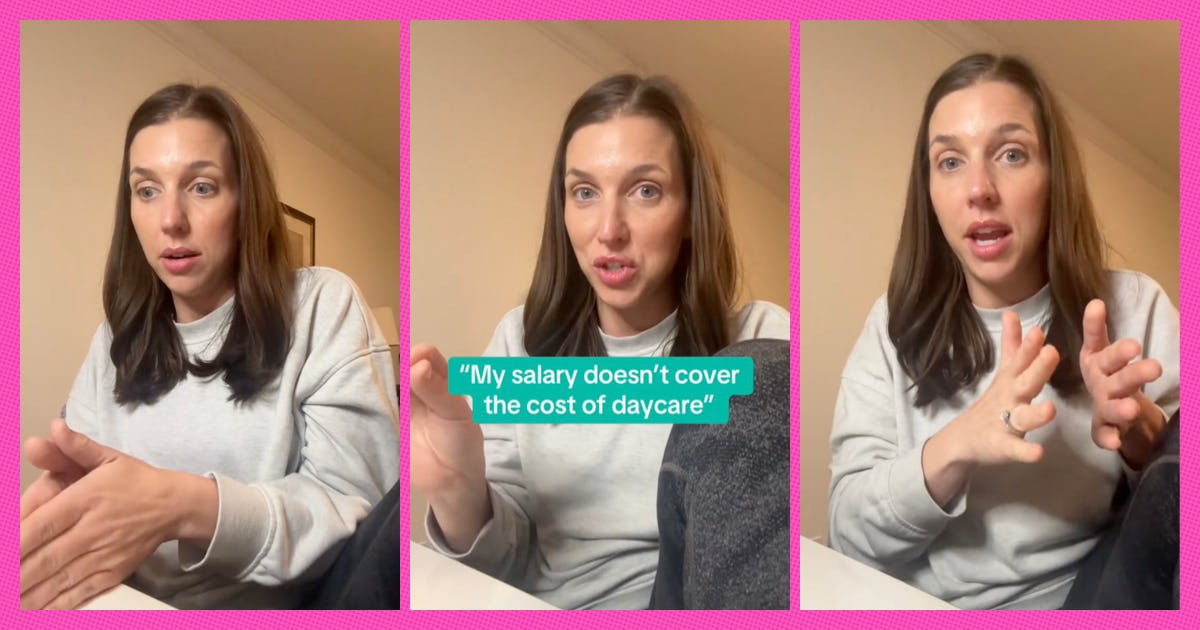Did you know that the average American family spends 27% of their income on child care? We don’t need to tell you that it’s hard to afford, but just in case you need confirmation, the Department of Health and Human Services states that “affordable” child care should cost no more than 7 percent of a family’s income. It’s no wonder, then, that many parents, often mothers, choose to drop out of the labor force and stay at home when their children are young, rather than spending the majority of their income on childcare. But TikTok creator Paige (@sheisapaigeturner) wants us to start thinking about this differently.
“I implore women to stop directly comparing the cost of childcare to wages,” she said. “When women become new mothers, they often calculate whether they can afford child care. When they do the math, they often compare their salary to the cost of child care.
For example: If child care costs $40,000 (scary, that’s not unusual for two kids in America), it may seem silly at first to stay in a job that pays $60,000 a year. Especially if you want to stay home with your kids. Is $20,000 a year (perhaps, assuming $60,000 is take-home pay rather than pre-tax salary) worth the stress of juggling a career and a family? But Page warns stay-at-home moms not to stop thinking about it at this time.
“This is very short-term thinking,” she said. “The cost of being out of the workforce, even for a short period of time, is significant. So even if you just want to take a few years off during those years when child care costs are high, when you try to re-enter the workforce, you’ll typically end up doing so at a lower cost.” Do this at a low rate, and your career will stagnate. Generally speaking, it’s very difficult to catch up financially with your retirement, benefits, and career.
Furthermore, she noted that this mentality “puts a burden on women.”
“When we think ‘my salary’ is not enough to pay for childcare, we assume that childcare is the mother’s sole responsibility. The way we should really be thinking about it is as a shared expense [between partners.]”
She thought it would be best to see your family income to understand the overall cost of child care, rather than simply comparing it to your salary.
“We don’t think about any other expenses in our family that way,” she said. “When we were considering applying for a mortgage from a lender, they didn’t just say ‘Dad, you have to pay for this yourself.'” No! We are looking at combining income and treating the mortgage as a joint expense.
Is it possible to “save money” by exiting the labor market and thus not have to pay childcare costs? certainly. But when it comes to long-term financial planning, you’re more likely to miss out not just on a short-term paycheck, but on future income, career growth and retirement goals.
“It’s not as simple as a one-to-one comparison of the five years your child will be in child care,” she asserts. “It does have lifelong consequences, especially for women.”
She went on to say that she wasn’t talking about you. cannot even shouldn’t Let the workforce stay home with their children. This is a valid choice! But it still has consequences that many people don’t consider—again, mostly for women.
The reviews are filled with success stories and cautionary tales.
“I worked for ‘free’ for the first three years of my career,” one commenter commented. “Now they are teenagers and I am a single mom but I bought my own house and we are thriving because of my choices.”
“I stayed home and lost my career/pension,” another shared. “We paid him more so I would be covered. I got nothing out of the divorce. He owed me thousands for the kids [support] And my career didn’t recover.
“A job is more than a paycheck,” said a third. “It’s about a career. It’s about freedom. It’s about independence and a life outside of home. It gives you so much!!
So if you and your partner are talking about your family and work life over the next few years, make sure you’re thinking as much about your later years as your life.




